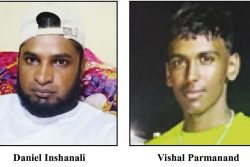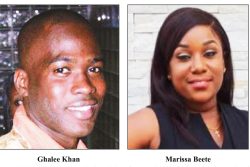By Tony Cozier At the ICC World Cup In CHANDIGARH
THE West Indies have gone into their three previous World Cup matches with Kemar Roach as their solitary fast bowler.
Twice Man of the Match, he has impressively done the business all on his own but, on two scores, head coach Ottis Gibson and his co-selectors might be persuaded to provide him with pace support for their critical Group B contest against Ireland in this northern Indian city tomorrow (starting 12 midnight south Caribbean time).
On inspection during their practice session at the Punjab Cricket Association Stadium yesterday morning, the pitch in the middle appeared dry and hard with a tinge of grass, hinting at more bounce and movement, if not pace, than those in Delhi against South Africa and the Netherlands and in Dhaka against Bangladesh.
Whatever the surface, Andre Russell’s exceptional record against the Irish alone presents a strong case for his inclusion for the first time.
In Jamaica’s 50-50 victory by six wickets over them at Discovery Bay in the Jamaica Festival last April, he took five for 42 from 9.3 overs.
That followed a first innings four for 41 and 108 off 65 balls, with 10 sixes, in the four-day match at Chedwin Park, albeit in a meaningless second innings in which all eleven Irishmen bowled.
On the West Indies ‘A’ tour of Ireland two months later, the 22-year-old Jamaican was at it again – 64 off 31 balls and six for 42 from his 10 overs in his team’s win by 50 runs in Belfast.
Russell is not express pace, but quick enough. He is a fierce, if erratic, hitter down the order and, as a once promising schoolboy sprinter in the homeland of sprinters, swift in the outfield. If his performances against the same opponents prove persuasive, Nikita Miller, a containing rather than attacking left-arm spinner, would make way. Even with such a change and whatever the surface, it is unlikely the West Indies would deviate from the strategy of using Sulieman Benn with the new ball, as he has so far done in each match.
 The towering left-arm spinner struck early against South Africa (the formidable Jacques Kallis in his third over) and twice against the Netherlands (Alex Kervesee in his fourth and Ryan ten Doeschate in his fifth).
The towering left-arm spinner struck early against South Africa (the formidable Jacques Kallis in his third over) and twice against the Netherlands (Alex Kervesee in his fourth and Ryan ten Doeschate in his fifth).
When he was hit for a couple of fours in the opening over against Bangladesh, Darren Sammy immediately withdrew him and took over himself. It is an obvious option if it happens again.
As it was Benn bowled Shakib al-Hasan with his second ball when brought back, the first of his four wickets for 18 in the Bangladeshi rout for 58.
It will be a week since that demolition of the team in the group that seemed the likeliest block the West Indies’ advance to the quarter-final, knockout stage. Bangladesh were, after all, placed one spot higher on the ODI table by the ICC at the time.
South Africa, India and England were the ones with the rankings and the recent records that made their progress all but certain.
It is now Ireland that realistically stands in the West Indies’ way to the last eight. To overcome them would virtually put them through and ease the pressure in the remaining matches against England and Indianext week.

Ireland’s sensational triumph over England in their second match, amassing 329 for seven with five balls in hand, was a repeat of their 2007 first round upset of Pakistan in a low-scoring contest at Sabina Parkand confirmation that, unlike the other associates here, they have progressed and are worthy contenders in such company. India beat them next up but it was not as straightforward as it looked on the scorecard. If one person, above all, knows that no one is to be taken lightly it is Gibson.
He was in the West Indies team forgettably routed for 93 (including 17 extras) by Kenya in the 1996 World Cup, also in India.
That wasn’t nearly as bad as the humiliation of 25 all out the 1969 team endured at the hands of the Irish in little town of Sion Mills. That is now a fading memory and, in any case, reportedly followed a late night involving dangerous quantities of Guinness. Even so, it is bound to be whispered into West Indian ears, even 31 years on.
The West Indies recovered from their more recent World Cup indignity against Kenya to reach the semi-final but there is a different structure to this year’s tournament that would render such a slipup all but terminal.
They were understandably energised by the manner of their Bangladesh win, if not by the “pebbles” hurled at their bus afterwards.
There was an intensity to their effort not regularly seen in recent times.
Gibson has drilled into his charges that it needs to be replicated tomorrow to contain the Irish enthusiasm and disregard of the odds against them, fired principally by big-hittng Kevin O’Brien whose World Cup record 113 off 63 balls that shattered England have made him an instant star in one country which treats its favoured cricketers as stars.

Kieron Pollard’s similar exploits in the Champions League and the Indian Premier League had the same effect. Those who show up tomorrow are in for more fireworks if they both are in the mood.
Gibson’s counterpart is a West Indian contemporary, Phil Simmons, the power-hitting opener of the 1990s. He took up his post in 2007 and is clearly a popular and successful coach.
He has under him the ideal balance of experience and youth.
Seven of those in this squad were in the eleven when Ireland, not yet fully accredited with ODI status, beat the West Indies by six wickets in Belfast following the 2004 tour of England, their lone win in a major match .
Against that, opener Paul Stirling, 20, and left-arm spinner George Dockrell, 19, are two genuine talents.
Six play, or have played, county cricket. Others were born and learned the game in the tough environment of Australia or South Africa. On record, the West Indies should prevail – as they have done in both the completed ODIs between the teams and as their ‘A’ team did in both their matches last year.
Yet it is just such history that seems to arouse the pluck of the Irish.








